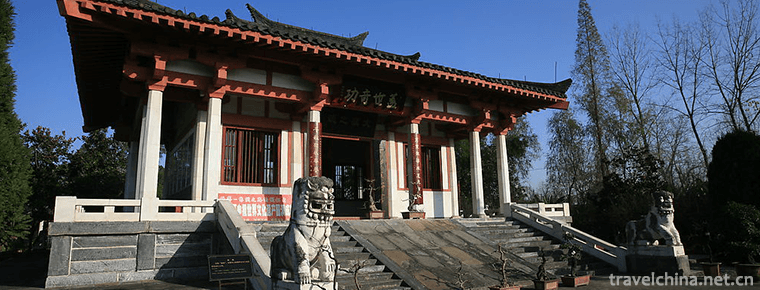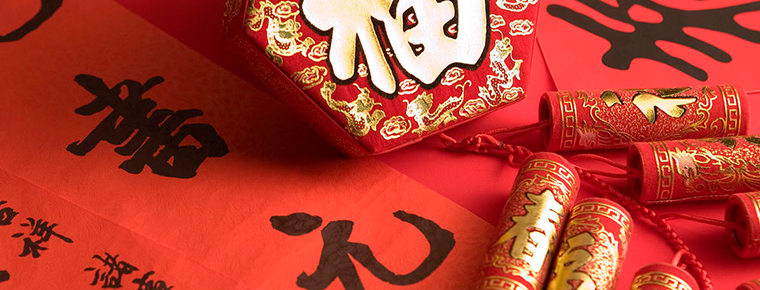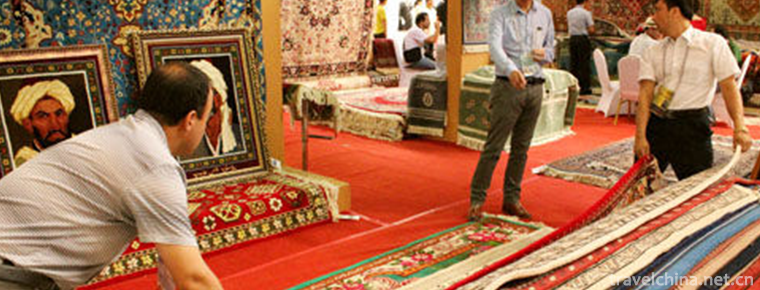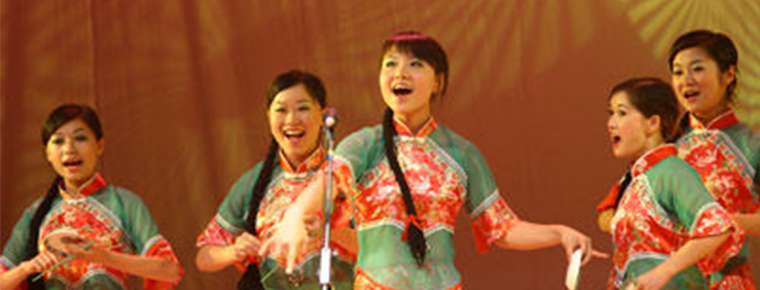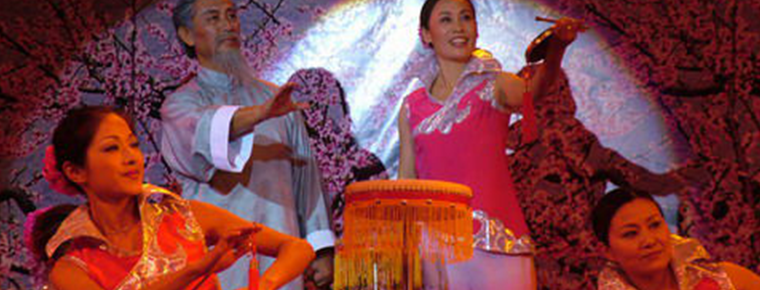Hushan Great Wall
Hushan Great Wall
Hushan Great Wall is situated on the Yalu River, 15 kilometers east of Dandong City. It is an important scenic spot in the national Yalu River scenic spot. It is across the river from Korea's Yuchidao and the ancient city of Yizhou. It's a great tourist attraction.
The Hushan Great Wall was built in 1469 AD, the fifth year of Chenghua in Ming Dynasty. Its main function at that time was to defend against the intrusion of Nuzhen people in Jianzhou. After Nurhachi became king, in order to preserve his "land of prosperity", he promulgated a law forbidding people from outside Shanhaiguan. People in Guannei are not allowed to farm or hunt in the area where the people were born. Therefore, he built the wicker edge, while mending the wicker edge, he ordered that most of the Great Wall of Liaodong, including the Hushan Great Wall, be demolished.
Introduction to Hushan
Originally known as Mal Mountain, Hu Mountain is like two standing tiger ears, also known as Hu'er Mountain. It evolved into today's Tiger Mountain in the Qing Dynasty. Hu Mountain rises alongside the Yalu River. It has a flat, solitary and broad horizon. It has a wide view of the fields and houses on the other side of Korea. As a national gate, the site of the Great Wall in Hushan is indeed of military significance. Dandong has been invaded by foreign enemies for many times, and Hushan has always been the first to be attacked. Anyone who knows the military knows how to occupy the commanding heights is equal to controlling the initiative of battle. The construction of the Great Wall in Hushan is logical. Wise Chinese ancestors, under the order of defending the country, responsibility, obligation and their lives, can not allow them to choose Hushan as a barrier. When King Zhihao, governor of the Ming Dynasty, climbed Jianhushan Fortress, he wrote a poem entitled "Looking at Korea on Mount Dengmar".
Hushan Scenic Spot is located about 12 kilometers northeast of Dandong City, Liaoning Province. It is the core scenic spot of Yalu River National Scenic Spot; National AAAA Scenic Spot; National Key Cultural Relics Protection Unit, across the river from the United Army Pavilion, one of the "Eight Scenic Spots of Korea". There are many famous scenic spots at home and abroad, such as Hushan Great Wall, Sino-Korean border "step by step", sleeping Guanyin, Great Wall History Museum, Ancient Trestle Road Site and so on, which are the starting point of the eastern end of the Great Wall of the Ming Dynasty. It is a scenic spot with the theme of ancient military and cultural tourism and the characteristics of Sino-Korean border tourism and red tourism.
However, after hundreds of years, the Great Wall of Hushan is almost on the verge of annihilation. For a long time, people mistook the eastern end of the Great Wall as the "first pass in the world" - Shanhaiguan. In fact, as early as in the History of Ming Dynasty, Military Records, it has been recorded that "in the end of Ming Dynasty, the border defense was prudent, from Yalu in the east to Jiayu in the west" has made it clear that the Great Wall of Ming Dynasty "starts from Yalu River in the East and from Jiayuguan in the west".
But until the early 1990s, the cultural relics and archaeological departments unearthed the continuous wall and wall foundation of the Great Wall in the north and south of Hushan Mountain. After a large number of field investigations by Luo Zhewen and other experts and scholars of the Great Wall, it was identified as the starting point of the eastern end of the Great Wall, which made the traditional statements in textbooks rewritten, and the government departments also organized a large-scale restoration work. Now the Hushan Great Wall is restored on the site of the Great Wall of the Ming Dynasty according to the "Design Plan for the Restoration of the Great Wall of the Hushan Mountains" adopted in 1992. The Great Wall of Hushan has now been restored to 1250 meters in length, crossing the street towers, beacon towers, enemy platforms, battlefields, horse faces and other twelve scenes, restoring the spectacular momentum of the head of the Great Wall of the Ming Dynasty. The restored Great Wall of the Ming Dynasty winds northward, close to Dandong City and across the river from the Democratic People's Republic of Korea. It has beautiful mountains and rivers, pleasant climate and beautiful scenery.
Main attractions
Hushan is one of the eight famous scenic spots in Andong in its early years. There are 28 scenic spots such as the Great Wall, Sleeping Buddha and Hukouya Cliff. It is an excellent tourist attraction in the outskirts of Dandong.
Huer Mountain, which stands steeply along the river, is characterized by abnormal peaks, steep and upright, and rugged rocks in the hills along the river. Up to the top of the Great Wall, you can see the scenery of the two countries. Looking up, you can see the tall buildings and Yalu River Bridge in Dandong, Jiangcheng, and the vast Yellow Sea. Looking back to the north, the streets are crisscrossed and the houses are just like houses. Danda Road goes around the foot of Mount Tiger and along the river. The restored Great Wall is like a pearl inlaid on the Yalu River and becomes a tourist attraction in the Yalu River scenic spot.
When the smoke is gone, the rivers and mountains are as beautiful as ever. Watching from the extreme, rivers are like belts, winding the horizon. The plain is fertile and the dogs and chickens hear each other. The dragon's head is straightened, and the male is like iron, which makes people feel proud. The "step by step" under the city is the nearest place to the border of the water route between China and DPRK. Looking at Hushan, it looks like a sleeping beauty lying on her back. She is graceful and lifelike from west to east.
Although the military significance of the Great Wall has been indifferent to modern science and technology, its rich cultural connotation and symbolic spirit can transcend the ages and become an inexhaustible driving force for our nation to advance.
Hushan Great Wall Scenic Area
The Great Wall of the Ming Dynasty lay like a giant dragon on the mountain. Shanxia Binjiang Road is connected with National Highway 201, and Bangshantai along the river is the eastern starting point of the Great Wall. Near Hushan, there are the ruins of the Han Dynasty Chengchi, Xi'an Pingxian, the Sino-Japanese War and the Russo-Japanese War. Hushan covers an area of four square kilometers and its main peak is 146.3m high. Peak top is the first fire platform of the Great Wall. Standing on the platform of the peak fire and looking around, the city of Yizhou in Korea, the Shazhou in Ma Shi in China and the Yalu River Bridge connecting Dandong and Xinyizhou are clearly visible. Planned Hushan green water lingering, the Great Wall ups and downs on the mountain, Yalu River shuttle Yahu Lake yacht, green trees and flowers and lake water, picturesque scenery. Folk villages, border trade markets, the Great Wall Museum and food streets will be built here. The Hushan Great Wall, which is being repaired with the approval of the State, has been completed for more than 730 meters. Soon the tour road along the river will lead directly to the Hushan scenic spot, which can be reached in only ten minutes from the urban area to the Hushan Mountain.
Climbing the enemy tower on the top of the mountain with an elevation of 146.3 meters will make people fully understand the profound meaning of "not being a good man without the Great Wall". Especially in autumn, the red leaves of the torch trees all over the mountain reflect the magnificent beauty of the Great Wall. Standing on the top of the Great Wall of Mount Hushan, you can get a glimpse of the scenery of China and DPRK. On the other side, you can get a full view of the natural scenery and the landscapes of the people of the Democratic Republic of Korea.
"Step by step" is one of the closest places between China and North Korea. It is named for the fact that the nearest step can be taken to North Korea. Tourists here can not only see the Korean people's lives, labor and work at close range.
The kilometer trestle road is another major scenic spot in the Hushan scenic spot. There are three ancient buildings in China: the Great Wall, the trestle road and the canal, among which the canal is the artificial river. You can see these three ancient buildings in Hushan Scenic Area. Trestle road is a passageway built on cliff cliffs with wooden pillars and boards. The kilometer trestle road in Hushan Scenic Area is a thrilling and exciting place to walk on the original trestle road ruins. Especially the section of "Hukou" is a place to test your courage. The dangerous road of "Hukou" is more than 20 meters long. It is a natural flat stone, which looks like a tiger's half-open mouth from a distance. Tourists walk on top of it with huge, rugged rocks protruding from it and almost no road under their feet. Out of Hukou, there is a downhill road ahead and a cable bridge ahead. It consists of five thick steel cables, which are more than 30 meters long. Walking and shaking on it gives people a sense of challenging the limits.
Hushan Great Wall History Museum
The Hushan Great Wall History Museum opened in May 2003. It is another Great Wall History Museum which introduces the defensive functions of the Great Wall in different dynasties after Jiayuguan, Badaling and Shanhaiguan.
The museum is divided into two floors, displaying the bricks and pottery of the Great Wall of the Ming Dynasty unearthed in Hushan, large oil paintings reflecting the history of the Great Wall, sculptures of historical figures and related historical documents, which comprehensively display the image of the Great Wall and its status and role in different times.
In the Hushan Great Wall History Museum, two large-scale half-view paintings are particularly noticeable. They are a combination of sound, light, electricity and other scientific and technological means. They vividly reproduce the magnificent scenes of the construction of the Great Wall in the Qin Dynasty and the tragic scenes of the demise of the Ming Dynasty and the fall of the Great Wall, giving people a sense of immersion.
Practical information
Scenic spot ticket price
Adult tickets: $60
Student tickets: 30 yuan
Great Wall Museum: 10 yuan
Self-driving into scenic spots: 10 yuan
Traffic information
1. There is a bus going to Hushan near the passenger station opposite Dandong Railway Station obliquely.
Daily departure time is as follows (February 2016 data)
From Dandong to Hushan Great Wall:
5:50, 6:50, 8:35, 9:50, 10:50, 12:00, 14:20, 16:30. Get on the bus and put in coins. The fare is 4 yuan.
From Hushan Great Wall to Dandong:
6:20, 7:30, 9:30, 11:00, 12:00, 13:00, 15:20, 17:10. Get on the bus and put in coins. The fare is 4 yuan.
2. You can take the Dandong-Kuandian shuttle bus. There are many shuttles every day, all through the Great Wall of Hushan. You can get off at Hushan. The highest fare is 6 yuan. When the Great Wall of Hushan returns to Dandong, almost all routes of buses along the highway near the scenic spot can stop at a beckon, with a maximum fare of 6 yuan.
3. The Great Wall of Hushan is about 12 kilometers away from the urban area. It can be reached by taxi, about 30 yuan.
Note: Buses and taxis are all along the riverside avenue, so the journey is almost 40 minutes, and buses are available every day, starting on time, the price of buses is much cheaper, cost-effective, so it is recommended to travel by bus according to departure time.
Matters needing attention
1. In the north of Hushan Great Wall, there is a "boat cruise to Korea" project. The local black guides and drivers (including regular taxis) can get a commission for bringing tourists there. They will mislead tourists and let them give up touring Hushan.
2. Don't believe the so-called "Hushan Great Wall closed" by local black leaders and black drivers. The Great Wall of Hushan has been open all the time, and the museums inside may be closed.
3. The Hushan Great Wall can continue to visit the trestle road and step by step at Pier 1. After the Great Wall tour, it can continue to walk forward without "returning to the original road".
4. Don't believe the cheap tickets of the ticket vendors. Tickets for the Great Wall of Hushan have been 60. Students are half-priced. There is no price increase to 70 yuan or 80 yuan.
5. Don't believe the so-called "the last day of the DPRK Opening Day". Every day is the last day in the black guide.
6. The new revision gate of Hushan Great Wall has not been put into use yet. Tourists should buy tickets to enter the nearby side door (with a sign) which is not so impressive. They should not abandon the tour until the main door is closed.
The best way for tourists who don't want to travel by boat to avoid being entangled by black guides is to wait for the bus to arrive according to the departure time.









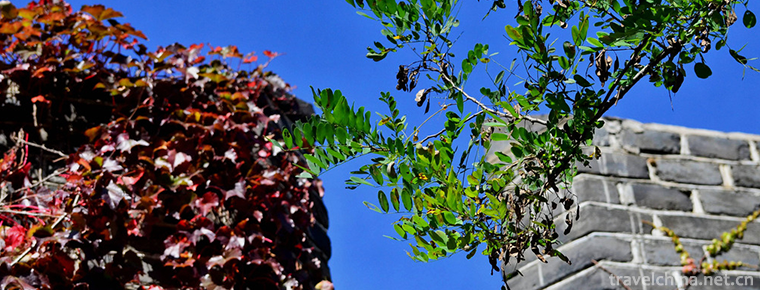
-
Tomb of Zhang Qian
Zhang Qian's tomb was the tomb of Zhang Qian, an outstanding diplomat, explorer and pioneer of the Silk Road in the Western Han Dynasty. In the third year of Emperor Yuanding of Han Dynasty (114 years.
Views: 241 Time 2019-03-16 -
Spring Festival
The Spring Festival, the Lunar New Year, is the first year of the year and also the traditional "New Year's Day". Commonly known as New Year, Spring Festival has a long history.
Views: 177 Time 2019-04-22 -
Carpet Weaving Techniques
Uygur carpet is a handicraft with a long history and tradition. It integrates painting, sculpture, knitting, embroidery, printing and dyeing. Characteristic.
Views: 109 Time 2019-04-26 -
Hubei Xiaoqu
Hubei Xiaoqu is one of the traditional operas in Hubei Province. It consists of "Hantan Xiaoqu" and "Tianzhao Xiaoqu". Han Tan Opera, also known as "Hankou Tan Opera" and.
Views: 178 Time 2019-05-03 -
Gongs and drums
The Gong and drum books used to be called "Taibaoshu", "Taibao" is derived from the activities of "Taibu" in the countryside of Shanghai suburbs and counties, which seeks.
Views: 120 Time 2019-05-15 -
Dough Flowers
Flower, commonly known as "flower bun", belongs to the art of facial sculpture. There are weddings, funerals, birthday gifts, Festival buns. Flowers are made of ordinary flour and special fl.
Views: 97 Time 2019-06-05 -
Xinyang Folk Songs
Xinyang Folk Song is the traditional folk music of Xinyang City. Xinyang City, known as the hometown of song and dance in Henan Province, has a rich stock of traditional folk music, dance and other tr.
Views: 311 Time 2019-07-06 -
Sichuan Agricultural University
Sichuan Agricultural University is a national "211 Project" with the characteristics of biotechnology, the advantages of agricultural science and technology, and the coordinated development .
Views: 399 Time 2019-08-31 -
Beijing Sport Univerrsity
Beijing Sports University was founded in 1953, formerly known as the Central College of Physical Education, renamed Beijing Sports College in 1956 and Beijing Sports University in 1993. It is a nation.
Views: 174 Time 2019-09-06 -
Beijing University of Chinese Medicine
Beijing University of Traditional Chinese Medicine is a national key university with traditional Chinese medicine as its main subject. It is directly under the management of the Ministry of Education..
Views: 132 Time 2019-09-22 -
Panzhihua before Sui Dynasty
Archaeological discoveries have proved that Panzhihua is one of the areas where human activities took place earlier. In addition to the "Yuanmou Man" and "Butterfly Man" relics found in nearby areas, the huilongdong ancient human site about 18000-12000 years ago has been found in Panzhihua City..
Views: 113 Time 2020-12-14 -
The evolution of Guangyuan
Guangyuan was ruled by Yin state in Xia Dynasty and Ju state in Zhou Dynasty. At that time, the state of Ju was in a state of tripartite confrontation with the states of BA (governing Chongqing) and Shu (governing Chengdu)..
Views: 299 Time 2020-12-15
